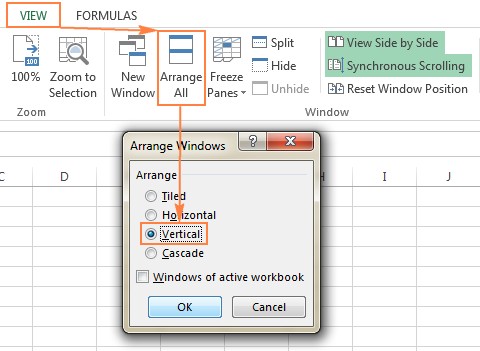Yes, you can compare two spreadsheets in Excel 2010 and this article by COMPARE.EDU.VN explains how. Discover the various methods, from using built-in features to leveraging third-party tools, ensuring you can effectively identify and analyze differences. Explore formulas, conditional formatting, and specialized add-ins to pinpoint variations in data, formatting, and structure, and enhance your spreadsheet comparison skills and improve your data analysis.
1. Comparing Excel Files Side by Side
This method is effective for smaller workbooks, the View Side by Side mode allows you to arrange two Excel windows to visually compare data.
1.1. How to Compare Two Excel Workbooks
To compare two Excel workbooks side by side, follow these steps:
- Open the workbooks.
- Go to the View tab, Window group, and click View Side by Side.
By default, Excel displays windows horizontally. To arrange them vertically, click Arrange All and select Vertical.
Ensure that Synchronous Scrolling is enabled in the View tab, Window group, for simultaneous scrolling and easier row-by-row comparison.
1.2. How to Arrange Multiple Excel Windows
For viewing more than two Excel files, open all desired workbooks, click View Side by Side, and the Compare Side by Side dialog box appears. Select the files to display alongside the active workbook.
To view all open Excel files, click Arrange All on the View tab and choose an arrangement option: tiled, horizontal, vertical, or cascade.
1.3. Comparing Two Sheets in the Same Workbook
To compare two sheets within the same workbook:
- Open the Excel file and click New Window in the View tab, Window group.
- This opens the same file in a new window.
- Click View Side by Side.
- Select the sheets you want to compare in each window.
2. Comparing Excel Sheets Using Formulas
This method helps in identifying cells with different values by creating a difference report in a new worksheet.
To compare two Excel worksheets, open a new sheet and enter the following formula in cell A1:
=IF(Sheet1!A1<>Sheet2!A1, "Sheet1:"&Sheet1!A1&" vs Sheet2:"&Sheet2!A1, "")
Drag the fill handle to copy the formula down and to the right. This formula compares corresponding cells in Sheet1 and Sheet2 and displays the differences.
3. Highlighting Differences Using Conditional Formatting
Conditional formatting can highlight cells with different values in two sheets, and it increases ease of visibility.
- Select all used cells in the worksheet where you want to highlight differences.
- Go to the Home tab, Styles group, and click Conditional Formatting > New Rule.
- Create a new rule using the formula:
=A1<>Sheet2!A1, where Sheet2 is the name of the other sheet.
4. Comparing and Merging Shared Workbooks
The Compare and Merge Workbooks feature is useful when multiple users collaborate on the same Excel file. Make sure to prepare the workbook properly before sharing.
4.1. Enabling Compare and Merge Workbooks
The Compare and Merge Workbooks command isn’t displayed by default. To add it to the Quick Access toolbar:
- Open the Quick Access dropdown menu and select More Commands.
- In the Excel Options dialog, choose All Commands under Choose commands from.
- Find Compare and Merge Workbooks, select it, and click Add.
4.2. How to Compare and Merge Workbooks
To merge copies of a shared workbook:
- Open the primary version of the shared workbook.
- Click the Compare and Merge Workbooks command.
- Select the copies you want to merge and click OK.
4.3. Reviewing Changes
To review the changes made by different users:
- Go to Review > Changes and click Track Changes > Highlight Changes.
- In the Highlight Changes dialog, select All in the When box and Everyone in the Who box. Clear the Where box and select Highlight changes on screen.
5. Comparing Excel Data and Information via Third-Party Tools
Built-in Excel features have limitations. For more thorough comparisons, third-party tools are available.
5.1. Synkronizer Excel Compare: A Detailed Overview
The Synkronizer Excel Compare add-in is a versatile tool for comparing, merging, and updating Excel files.
5.1.1. Comparing Two Excel Files
To compare two Excel files with Synkronizer:
- Go to the Add-ins tab and click the Synkronizer icon.
- Select the workbooks and sheets to compare.
- Select the sheets to compare.
- Choose a comparison option:
- Compare as normal worksheets
- Compare with link options
- Compare as database
- Compare selected ranges
- Select content types and filters as needed.
- Click the Start button.
5.1.2. Visualizing and Analyzing Differences
Synkronizer generates a summary report and a detailed difference report.
- The summary report shows all difference types.
- The detailed report provides specifics on each difference.
Clicking on a difference in the detailed report selects the corresponding cells in both sheets.
A hyperlinked difference report can also be created in a separate workbook for easier navigation.
5.1.3. Comparing Multiple Sheets
Synkronizer can compare multiple sheets at once, presenting all matching worksheet pairs in the summary report.
5.1.4. Highlighting Differences
By default, Synkronizer highlights all found differences.
- Yellow indicates differences in cell values.
- Lilac indicates differences in cell formats.
- Green indicates inserted rows.
Relevant differences can be highlighted by clicking the Outline button and selecting the required options.
5.1.5. Updating and Merging Sheets
The merge function allows you to transfer individual cells or move different columns/rows from one sheet to another.
Differences can be updated by selecting them on the Synkronizer pane and clicking one of the update buttons.
5.2. Ablebits Compare Sheets for Excel: A Deep Dive
Ablebits Compare Sheets for Excel is a tool designed to provide an intuitive comparison experience.
5.2.1. Using the Comparison Tool
-
Click the Compare Sheets button on the Ablebits Data tab, in the Merge group.
-
Select the worksheets to compare.
-
Select the two worksheets you want to compare.
-
Choose a comparison algorithm:
- No key columns
- By key columns
- Cell-by-cell
-
Specify a match type:
- First match
- Best match
- Full match only
- Specify which differences to highlight and ignore.
- Click the Compare button.
5.2.2. Reviewing and Merging Differences
The worksheets open side-by-side in a special Review Differences mode.
The differences are highlighted with default colors:
- Blue rows exist only in Sheet 1.
- Red rows exist only in Sheet 2.
- Green cells are different cells in partially matching rows.
Use the vertical toolbar to manage the differences:
5.3. xlCompare: A Comprehensive Utility
xlCompare allows for the comparison of files, sheets, names, and VBA Projects, identifying changes and enabling quick merging.
5.4. Change pro for Excel: Detailed Comparison Features
Change pro for Excel enables the comparison of sheets in desktop Excel and on mobile devices, with server-based options available.
6. Online Services for Excel File Comparison
Online services provide a quick way to compare Excel sheets without installing software. While security might be a concern, these services can be useful for non-sensitive data. An example is CloudyExcel.
Upload the files, click Find Difference, and the differences are highlighted.
7. Why Comparing Spreadsheets in Excel 2010 Matters
Comparing spreadsheets in Excel 2010 is essential for maintaining data accuracy, identifying discrepancies, and ensuring consistency. Whether you’re managing financial records, tracking inventory, or analyzing sales data, the ability to effectively compare spreadsheets can save you time and prevent costly errors. By using the techniques outlined in this guide, you can enhance your analytical capabilities and make more informed decisions based on reliable data, improve your data integrity, reduce errors, and improve collaboration.
8. Essential Tips for Accurate Spreadsheet Comparison
- Use Consistent Formatting: Ensure both spreadsheets use the same formatting styles for dates, numbers, and text to avoid false positives.
- Sort Your Data: Sorting data in both spreadsheets by a common key column can make it easier to visually identify differences.
- Double-Check Formulas: Verify that formulas are consistent and accurate in both spreadsheets to prevent calculation errors.
- Document Changes: Keep a log of all changes made during the comparison process to track modifications and ensure accountability.
9. Streamlining Your Workflow with COMPARE.EDU.VN
COMPARE.EDU.VN is designed to simplify the process of comparing different types of information, offering detailed, objective comparisons to help you make well-informed decisions. Whether you’re evaluating product features, service options, or academic programs, COMPARE.EDU.VN provides side-by-side analyses and expert insights. This comprehensive approach ensures that you have all the necessary information to choose the best option for your needs, saving you time and reducing uncertainty.
10. Frequently Asked Questions
- Can I compare two Excel files if they have different numbers of rows and columns?
- Yes, using formulas or third-party tools allows you to compare files even with varying dimensions, though manual methods may be challenging.
- How do I compare two Excel files with different layouts?
- Third-party tools like Synkronizer or Ablebits Compare Sheets are designed to handle different layouts, aligning data based on key columns or best-match algorithms.
- Is it possible to ignore case sensitivity when comparing text in Excel?
- Yes, some third-party tools offer options to ignore case sensitivity. In formulas, you can use functions like
UPPERorLOWERto convert text to the same case before comparing.
- Yes, some third-party tools offer options to ignore case sensitivity. In formulas, you can use functions like
- Can I compare password-protected Excel files?
- To compare password-protected Excel files, you’ll need to unlock them first. Most third-party comparison tools will prompt you for the password.
- How can I find and remove duplicate rows in Excel?
- Go to the Data tab, click Remove Duplicates, and select the columns to check for duplicates. Ensure you back up your data before removing duplicates.
- What is the best way to compare large Excel files?
- For large files, third-party tools are more efficient than manual methods. They are designed to handle large datasets and provide detailed comparison reports quickly.
- Can I compare the VBA code in two Excel files?
- Yes, tools like xlCompare allow you to compare VBA projects, identifying differences in the code.
- How do I highlight differences in entire rows instead of individual cells?
- When using conditional formatting, adjust the formula to reference the first cell in the row. For example,
=$A1<>Sheet2!$A1will highlight the entire row if the value in column A differs.
- When using conditional formatting, adjust the formula to reference the first cell in the row. For example,
- Are there any free Excel comparison tools available?
- Online services like XLComparator and CloudyExcel offer free comparisons for smaller files, but they may have limitations on features and security.
- How do I merge data from two Excel files without overwriting existing data?
- Use third-party tools with merge functions that allow you to selectively transfer or update data, ensuring that existing data is not overwritten unless intended.
Call to Action
Ready to make data-driven decisions with confidence? Visit COMPARE.EDU.VN today to explore detailed, objective comparisons of products, services, and ideas. Don’t navigate complex choices alone – let compare.edu.vn help you find the best option tailored to your needs. Contact us at 333 Comparison Plaza, Choice City, CA 90210, United States or via Whatsapp at +1 (626) 555-9090 for more information.

